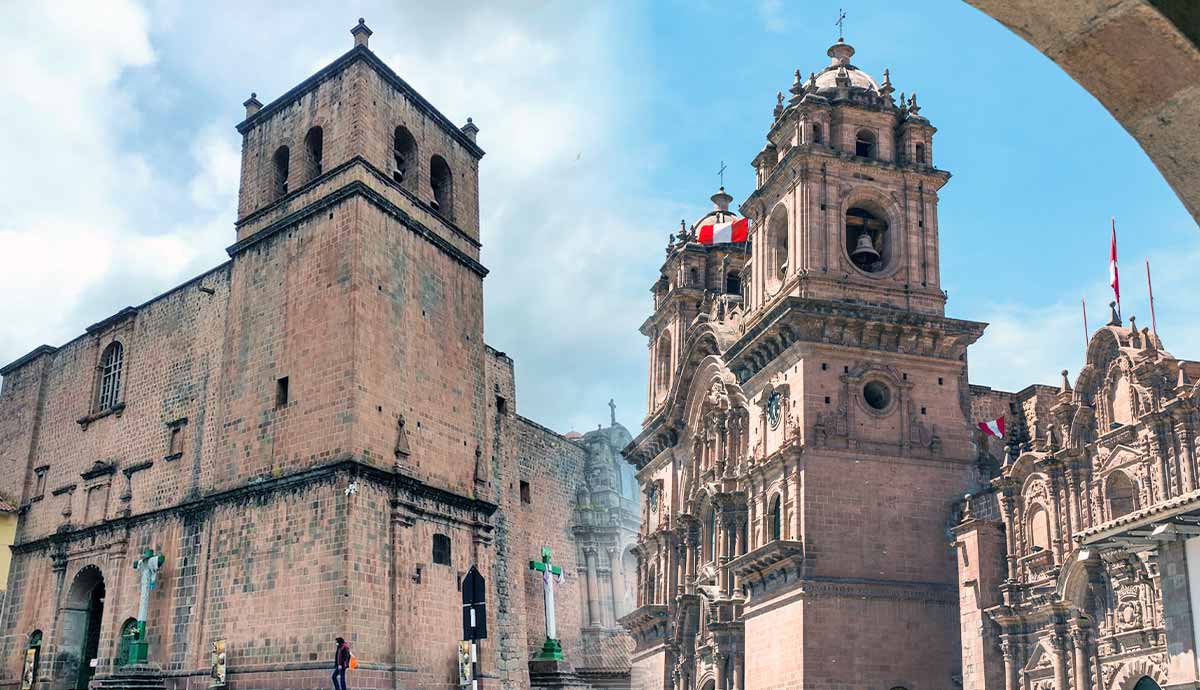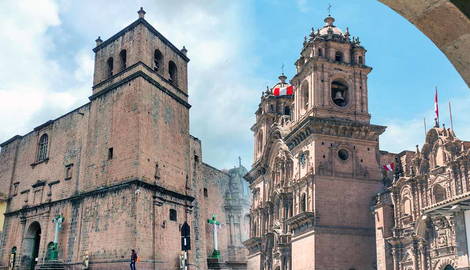
In the high Andes Mountains of Peru lies Cusco, the former capital of the Inca Empire. It’s a popular destination for trekkers looking to visit monuments such as Machu Picchu. It’s also a protected UNESCO World Heritage Site. The city preserves its cultural legacy in dozens of renowned museums. From art to history, Cusco’s museums are full of impactful exhibits that will inspire any visitor. Below are the top 10 museums of Cusco, Peru, the ancient capital of the Inca Empire.
1. Inka Museum in Cusco, Peru

Cusco’s Inka Museum is a small yet fascinating museum dedicated to the Inca Empire and its culture. It is located in the Casa del Almirante, which was built in the 1580s. The museum features original Inca stonework at the base and a colonial-style stone facade and cloisters. For centuries, it belonged to influential conquistadors and political figures of the Peruvian viceroyalty.
The building is full of beautiful ceiling designs and colorful paintings on the wood. You’ll find plenty of colonial art to enjoy even before you enter the museum. Some of the building’s highlights include the fountain and colonial garden space. Inside, you’ll see pre-Inca and Inca artifacts, including ceramics, ceremonial objects, and dolls. There are also murals and carvings depicting the history of the empire and the brutal period of Spanish colonization.
The museum is located in Cusco’s historic center. After your visit, don’t miss the chance to walk through the narrow alleyways that connect to the museum. The buildings along the alleyways contain original Inca stonework walls and carvings.
2. Pre-Columbian Art Museum

The Museo de Arte Precolombino is a fantastic museum located in a 16th-century colonial building known as Casa Cabrera. It was started as a collaboration between the BBVA Peru Foundation and Lima’s Larco Museum as a museum dedicated to Peru’s ancient history.
The museum contains well-curated exhibits that feature pre-Hispanic Peruvian artifacts and art spanning over 3,000 years. You’ll get to come face-to-face with Inca ceramics, pre-Inca textiles, and wooden carvings from throughout Peru. You can follow a path through the museum, where you will be able to learn about the societies that called the Andes home before the Spanish invasion.
The collections are displayed in 10 rooms. There are rooms dedicated to artifacts made from gold, silver, wood, and shells. One room displays artifacts from the earliest days of Peruvian history. The five other rooms take you through the art and culture of the pre-Inca and Inca societies.
3. Qorikancha Archaeological Site and Museum

Qorikancha was once the center of Inca spirituality. It was dedicated to the sun god Inti and had walls covered in gold. After the Spanish colonizers invaded Cusco after a long and bloody war, they disassembled the temple to build the Church and Convent of Santo Domingo of Guzmán and other buildings.
The entire space functions as a museum and cultural center. Inside, you’ll walk through the 17th-century church before entering the central area, where the original Inca stone walls and ceremonial altars stand. The intricate stonework is so precise that it looks like a movie set.
Through the displays, you’ll learn about the temple and its purpose. You’ll also be able to go through the former temple grounds and see its well-preserved walls. During festivals and events, the Qorikancha museum and surrounding garden transform into a ceremonial space with dancers and people celebrating. The museum is a must-see destination for anyone interested in experiencing the history of the Inca.
4. Machu Picchu Museum at Casa Concha

Cusco is the starting point for visitors going to Machu Picchu. Although it’s the experience of a lifetime, the hilltop archeological complex is just one of the places where you can see original artifacts from the site and learn about its intriguing history. At Cusco’s Machu Picchu Museum, you’ll see hundreds of artifacts collected from the site at Machu Picchu in 1912 by American politician and explorer Hiram Bingham. You’ll see replicas of the Machu Picchu site and recreations of its ceremonial spaces, agricultural terraces, aqueducts, and homes.
There’s plenty of information about the site and Bingham’s expeditions on display. From pottery and tools to art and ceremonial instruments, you’ll find hundreds of artifacts. There are also ceramics unearthed from the museum site itself. The museum is housed in an 18th-century colonial house that was once the site of an Inca palace. It has an open courtyard and elaborate cloisters around the center. The building’s intricate stonework and masonry are a highlight for anyone interested in colonial building styles.
5. Santa Catalina Monastery

The Santa Catalina Monastery and Museum is located in one of the oldest surviving buildings in the city. It was built in 1610 on the ruins of Acllahuasi, an Inca Imperial religious institution that housed chosen women for the worship of the sun god Inti. It became a monastery and eventually housed nuns.
It features colonial Baroque architecture and intricate rock carvings that once belonged to the original Inca structure. The museum’s displays show recreations of monastic life, including life-size mannequins of nuns praying, sowing, and resting. A highlight of the museum is the preserved architecture and woodwork inside. You’ll get to experience hundreds of years of carvings and monastic art, including beautiful murals painted on the inside arches and walls.
6. Museum of Popular Art

If you love folk art, then Cusco’s Museum of Popular Art is a must-visit destination. Located in one of the oldest neighborhoods of Cusco, the museum has two floors of exhibits ranging from traditional textiles and masks to sculptures and costumes. You’ll see ceremonial pieces and unique handmade items from the Cusco region. Each piece is handmade by local artists and represents several centuries of artistic traditions and styles.
Highlights include hand-woven rugs, hand-carved masks, and human figures. You’ll also see traditional clothes used in festivals and celebrations and learn about the artists who made them. The exhibits also contain pieces by famous Peruvian folk artists and National Masters of Crafts, including Santiago Rojas, Antonio Olave, and Maxi Palomino de Sierra.
7. Regional Historical Museum of Cusco

The Regional Historical Museum of Cusco is located inside a 16th-century colonial building. It was constructed on top of the Inca Cusipata plaza, the former central plaza of the city during Inca rule. The Spanish Jesuit Pedro de Oñate built the original house before it was transferred to the conquistador Captain Sebastián Garcilaso de la Vega. Vega’s son, Inca Garcilaso de la Vega, grew up in the house and went on to become one of Peru’s most famous writers and early historians.
When you visit the museum, you can learn about the history of the Vega family through art and artifacts. Other artifacts include Inca ceramics, textiles, and viceregal paintings. Centuries-old furniture and pottery are also displayed within the halls and under the building’s dramatic cloisters.
8. Museo Maximo Laura

Tapestry is one of Peru’s greatest contributions to global art, and artist Maximo Laura is one of the country’s most famous contemporary artists who preserves the style. Laura comes from five generations of weavers and blends various ancestral styles and symbols in his work. His work has earned him several awards, including a UNESCO Prize for Latin American art and the National Living Human Treasure of Peru from the Peruvian government. Laura’s work is displayed around the world in organizations such as UNESCO headquarters and the World Bank in Washington, D.C. In the museum, you’ll get to walk through two floors of exhibits that showcase Laura’s extensive collection of handwoven textiles. From dream sequences to creation stories, each tapestry tells a deep story that evokes centuries of traditions and artistic heritage.
9. Museum of Religious Art

After the Spanish colonizers took over Cusco, the Catholic Church established several churches and religious institutions throughout the city. One of these institutions was the Archbishop’s Palace, a 16-17th-century Spanish colonial-style building built within the ancient Inca walls of the original city. Inside the palace is the Museum of Religious Art. This small but well-curated museum holds one of the city’s most extensive collections of religious art and artifacts. Most pieces are viceregal and display church history and images of the Spanish conquest of Peru and the Americas.
The museum is also a place to see the unique mixture of artistic styles and colors of the Escuela Cusqueña art style, which developed in Cusco between the 16th and 18th centuries. It was created by artists who fused Indigenous artistic traditions with Spanish religious imagery and symbolism.
10. Saint Francis de Asis Church and Museum in Cusco, Peru

Towering over Plaza San Francisco is the Saint Francis de Asis Church and Museum. Built in the mid-16th century, the church features beautifully restored cloisters, stone arches, and intricate wooden carvings. It’s one of the few colonial buildings that survived Cusco’s destructive earthquakes in the 17th and 19th centuries.
Several halls and rooms contain centuries-old church artifacts, artistic pieces, and other objects dating back to the 16th and 17th centuries. You’ll also see original Franciscan paintings depicting various religious scenes and historical events. For those inclined, the museum also features catacombs, which are curated for visitors. Inside the catacombs are human bones and skulls arranged in patterns to signify the transition from life to death.










